概要
Social changes brought about by DX
Compared to 10 years ago, our lives have undergone a remarkable transformation. Looking back, 10 years ago, society / technology was already mature, and we could not have imagined the huge changes in 10 years: the spread of Covid-19 has made remote work and online meetings / classes the norm, digital platformers, led by GAFA, have emerged, and smartphones One can purchase anything and have it delivered to their home.
In the near future, automatic drone delivery, self-driving cars, and simultaneous translation into foreign languages by AI will allow anyone to communicate with people around the world without language barriers. We can now imagine a world where these things will be commonplace. It is no exaggeration to say that the world of the near future that we envisioned 10 years ago has already arrived.
The reality and merits of DX
This change is what DX is all about. It is something that can create a new world by drastically changing our lifestyles, behaviors, and values. DX can change the world and make it better.
The term DX was first used in a paper published by Professor Erik Stolterman of Umea University, Sweden, in 2004, and its impact in transforming society to this extent in less than 20 years since the birth of the concept is significant. It is no exaggeration to say that the success or failure of DX is a watershed moment for society and businesses.
The reality is that DX is divided into two groups: a small number of winners and many losers.
Vision Consulting is concerned that if this polarization continues, the ability of DX to improve the world will be hampered.
A small number of winners means an oligopoly of the market, and the winners will have the right to determine prices (Figure 1).
Amazon’s example of using digital technology to remove pain points in the customer journey and enter the market is a typical example of DX, but if they become an oligopoly and have no competition, they will have no reason to offer their services at a low cost. Moreover, unprofitable businesses/services will be cut off, and life on remote islands may even become more inconvenient than it was before DX. This is why we believe it is necessary to promote and realize DX not only in some areas, but in society and the market.
So, why is DX so difficult?
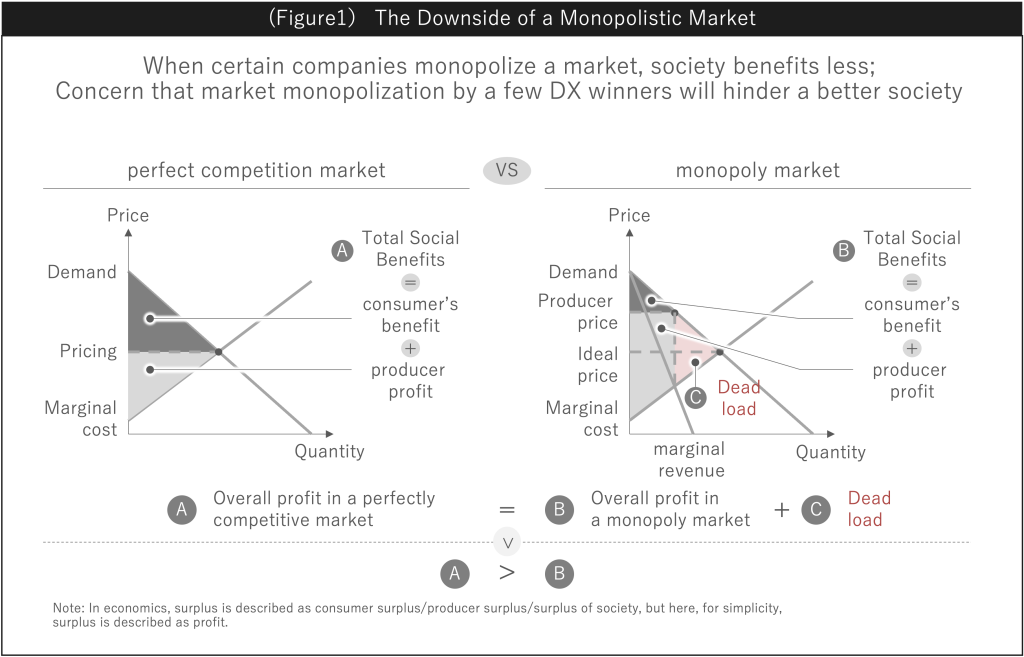
Digital Transformation = DX
To begin with, defining DX is difficult.
In its 2021 DX White Paper, IPA defines DX as “the transformation of products, services, and business models based on the needs of customers and society, as well as the transformation of operations themselves, organizations, processes, and corporate culture and climate, in order to establish competitive advantage, by leveraging data and digital technology in response to rapid changes in the business environment. In short, “digital” is defined as “the use of digital technology to transform products, services, and business models based on customer and societal needs.
Simply put, it can be said that DX is about digital transformation.
There is often debate about what DX is for and what DX does, but to begin with, DX encompasses both the means (digital) and the goal (transformation).
There are countless options and directions for both the means (digital) and the goal (change).
Even if we say in one word that DX is not going well, there are countless possibilities for the direction of change, the driving force for implementation, the technical capabilities of digital technology, the choice of technology to use, and the location of possible factors.
In fact, I feel that in many cases, the causes of why DX is not working are not clearly defined. It is very difficult to choose the correct answer from countless combinations. Moreover, there is no single right answer in realizing new value and new businesses such as DX.
Herein lies the difficulty of the road to re-emergence for DX losers.
Position change by DX
So, what is the essence of DX?
In the DX White Paper, it is the transformation of business models and the establishment of competitive advantage through transformation.
The definition of DX should be based on whether the company has achieved transformation and established competitive advantage. Even paperless, a typical example of digitalization, is DX if it realizes overwhelming competitiveness/changes people’s values and behavioral patterns (Figure 2).
Transformation and the establishment of competitive advantage can be described as a change in position. In business strategy, position has a variety of meanings (Figure 3).
A typical example of this is when a company at the upstream of the value chain moves downstream with direct customer contact through DX. In particular, the reversal of the position of subcontractors such as suppliers to integrators at the top of the value chain pyramid structure is an example of a position change that has a significant impact (Figure 4).
It has been proven that DX can reverse the hierarchical structure that has been maintained for many years, and DX has brought great possibilities to business. On the other hand, in many cases, position changes cannot be handled by extending existing processes.
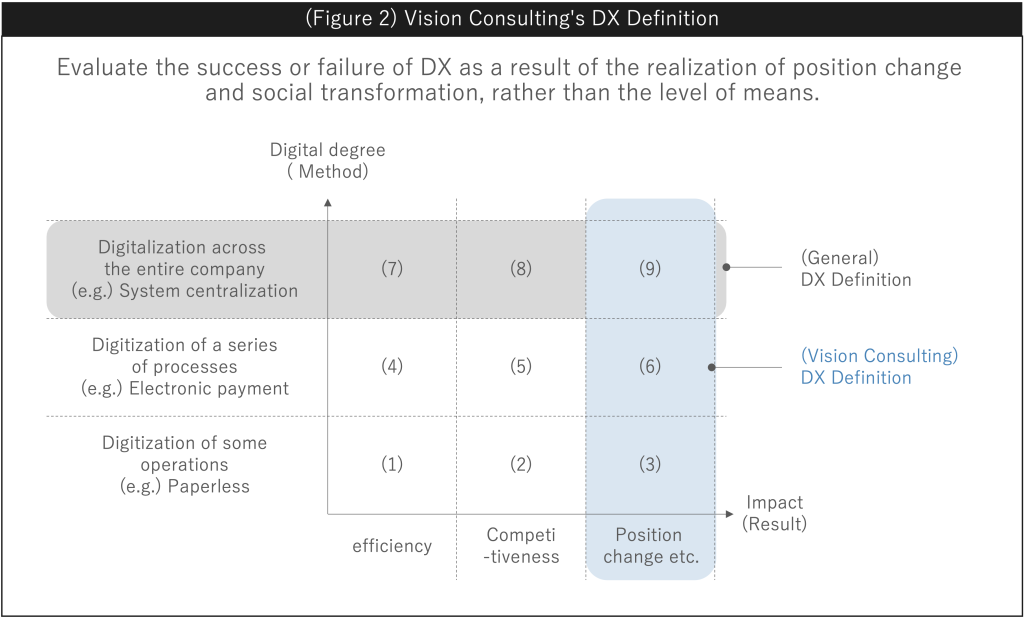
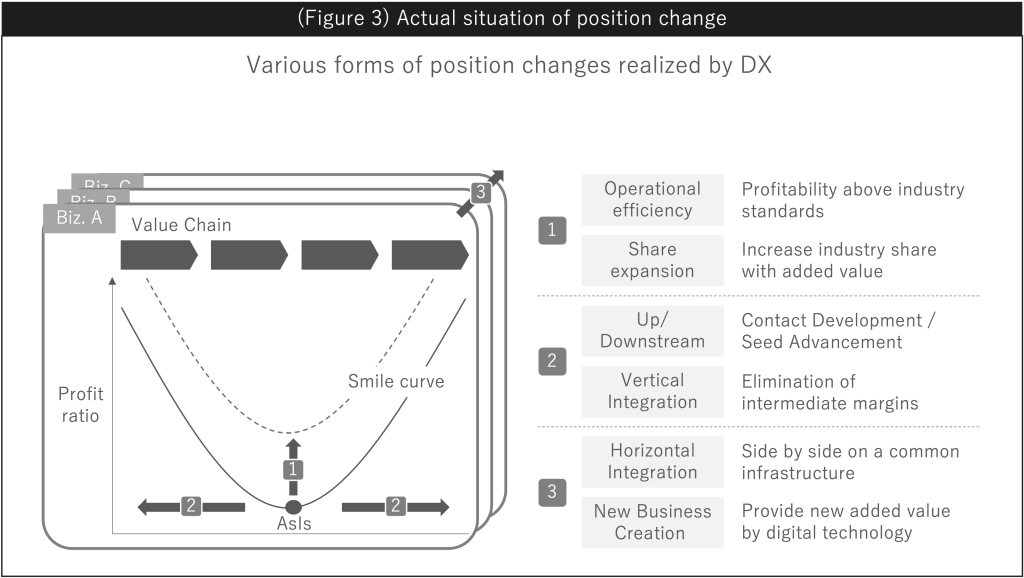
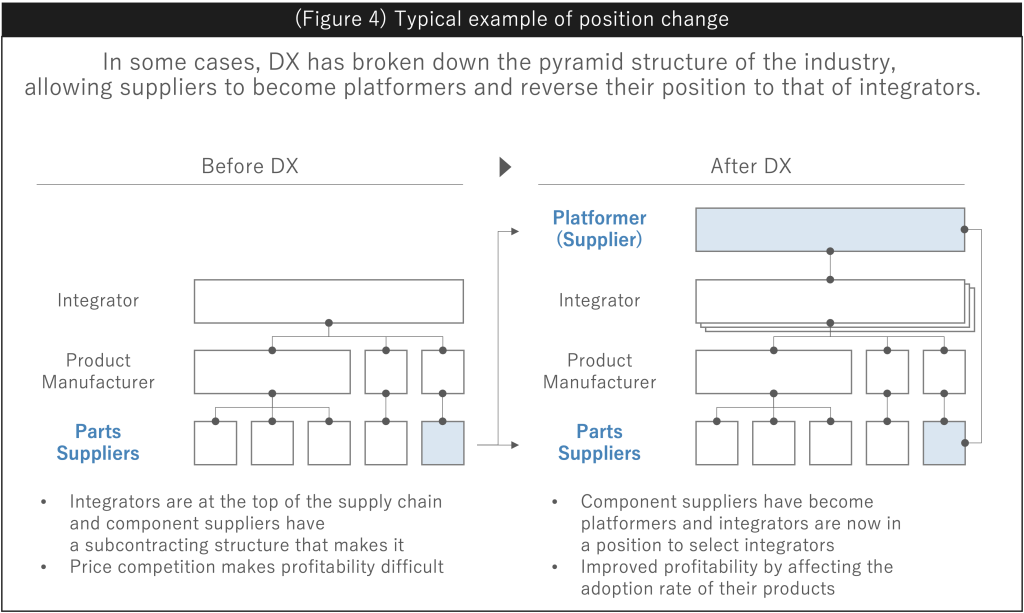
Importance of Strategy across Execution in DX
The success stories of some startups and digital nature companies are spectacular and vivid. The focus is on the sharpness of the business model and target audience, and this appears to be a success factor. On the other hand, there are countless examples of companies that spend a great deal of time but fail to commercialize their business. This is the result of overlooking the fact that for most companies, DX cannot be realized through unique business models alone.
It is the implementation that is most burdensome. For the average company with an existing business, these business model changes, and DX initiatives are always painful. It is essential to visualize the complex business processes that complement legacy systems and to clear the way for the realization of DX.
In addition, if DX is to be promoted, it will be necessary to reorganize the organization and human resources, and change the company’s foundation, including the code of conduct. This is an area that cannot be realized unless key personnel work together with management to seriously tackle the task.
However, there are many cases in which outside companies have taken some of the advanced success stories as a reference, only to find that the project has been abandoned halfway through due to enormous distortions in feasibility and implementation.
Or, conversely, there are many cases where the introduction of digital tools was intended for DX, but when it comes to the implementation phase, the purpose and means are reversed and the introduction of the tools itself becomes the objective, and DX does not progress forever.
We are sure that you have seen this happen at least once, with a bitter feeling in your heart, even if the vision is lined up in a grating manner. If you think that mindset and corporate culture are the only explanations for why outside companies are failing, this is a yellow light. On the contrary, DX has become a convenience for budgeting and securing resources for core system implementation. It is dangerous if there are sites where the consideration of what to aim for while minimizing the impossibility of business operations has been omitted.
No matter how suggestive and detailed the strategy may be, DX that is missing the perspective of muddy execution or DX that does not have a consistent blood flow between strategy and execution will not budge.
Therefore, the key is to follow a straight line from strategy to execution, and to solve the strategy and execution at the same time to a certain extent.
Importance of Agile Development in DX
However, this is very time-consuming, and there are scattered cases of repeated PoC but no progress beyond that point.
There are many PoC that lack a PoC to verify what and how with what hypotheses for strategy and execution. In addition, by the time all verifications are completed, it is highly likely that the evolution/trends of the market and technology will be very different from what was originally envisioned in the VUCA environment.
However, it is not realistic to complete the vast amount of muddled reform implementation before the market / technology changes. The key to meeting this challenge, then, is agile development.
However, there are very few cases where correct Agile development is applied to DX promotion.
The correct application of agile development is closely related to how much emphasis is placed on the execution part of DX promotion (Figure 5). The correct DX procedure is to gradually increase the distance (1~5) with PoC that are close in direction to the direction/distance to be advanced, and to sequentially implement PoC (1~5) with large deviations (Δθ) from the derived peripheral angles, which are equivalent in distance to the PoC executed with the same directionality. This 1→5 / 1→1~5 procedure is the correct agile development procedure.
For this purpose, it is necessary to correctly determine the direction and distance. This is exactly the part that requires a steady, muddy business/data analysis and organization. Simply drawing a clean strategy or business model will not be enough to determine this.
The greater this distance (ℓ), the greater the misdirection (r), and the greater the sum of the product (Σ(ℓ×r)), the greater the moment of difficulty, and the more the organization is pushed around, the more exhausted it becomes.
Incorrect agile development (Figure 5) is a typical example. By starting with what is possible without having a clear idea of what to do, or by promoting digitalization ahead of other priority points, the direction and distance (G) are unclear, and the degree of difficulty of each PoC is not estimated. As a result, not only does the organization become exhausted, but even the crucial G is swung to excessive moments, resulting in repeated failures.
It is no exaggeration to say that the footprint toward the To-Be image will determine the success or failure of DX.
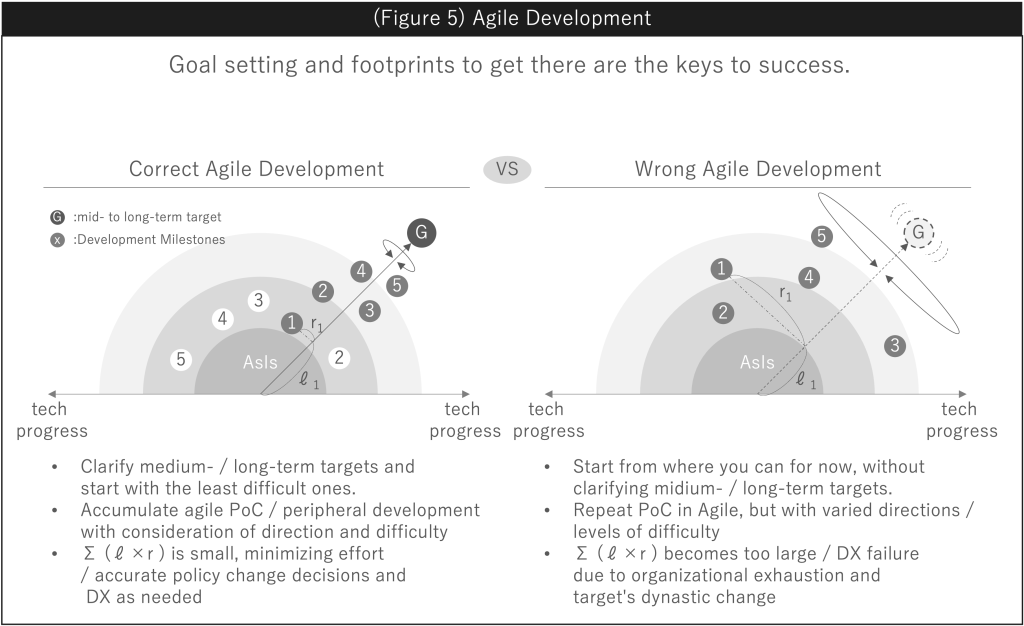
Vision Consulting Mission
Failures have piled up due to misguided agile development, and now DX loser companies are being mass-produced. This is not the way to improve society.
We are a consulting firm that truly believes in providing new value to society and creating a better world. In order to break through this situation, we have been refining our one-stop and run-along support, and agile development. Our mission at Vision Consulting is to create a better world by opening DX to many companies from a few successful ones with strategy, execution, and agile development.


